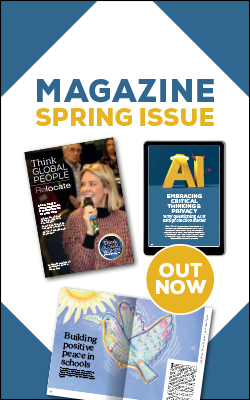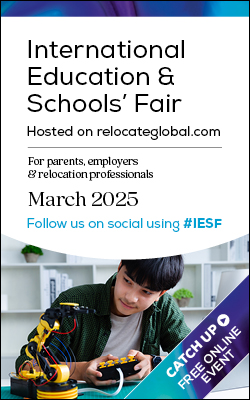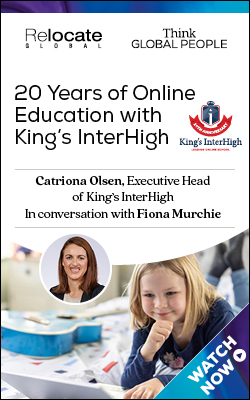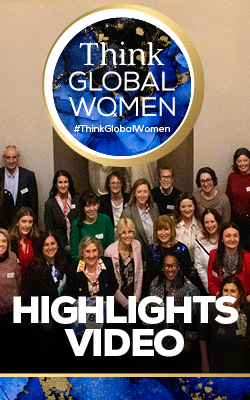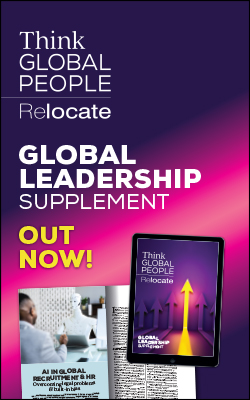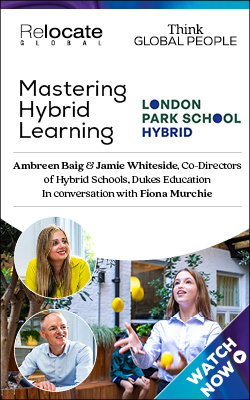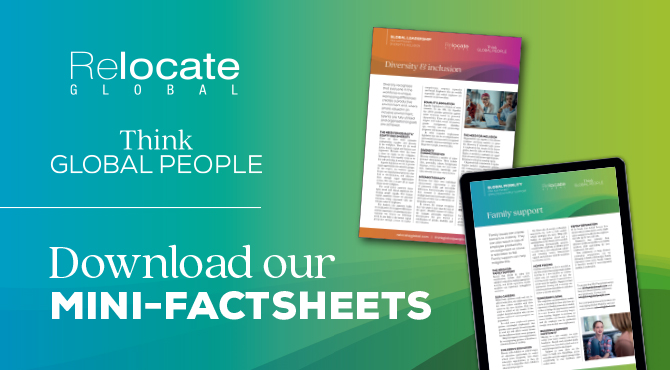Embracing a human approach to AI
This year’s BETT education show held in London drew over 35,000 visitors and honed in on the vast potential of AI, as well as risks and positive outcomes when we opt for a human-centred approach.
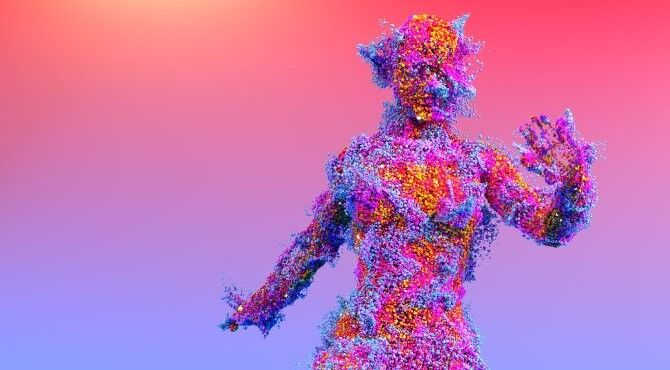
This article is taken from the Spring 2025 issue of
Think Global People magazine
View your copy of the Spring 2025 issue of Think Global People magazine.Addressing a packed arena, Sir Stephen Fry and author and CEO of the Stemettes, Dr Anne-Marie Imafidon, kicked off with what makes us human in an augmented world.The session took a deep and rational look at the advantages and challenges of AI, from revolutionising industries to redefining the skills children need for the future of work and examined ethics, inclusion and security, laced with Fry’s signature metaphors and Imafidon’s tech insights.Highlighting some advantages of AI, they discussed the elimination of repetitive, back-breaking industrial jobs, as well as efficiencies that could be made to more routine cognitive work. Radiology, and other imaging tasks were given as an example, which can be strenuous and time-consuming but when assisted with AI could help humans review with greater speed and efficiency.But there are many roles that are fundamentally human, stated Fry. Gardening, for example. “Planting seeds, assessing the soil and bringing a garden to life will [continue to] be a very human thing, a very beautiful and important thing.”So, where do teachers sit? Imafidon asked. “Teachers are gardeners, that’s exactly what they are,” said Fry. “They bring things to life and encourage growth. They supervise and use their judgement, instinct, human knowledge and understanding of different children to educate and nourish – this one needs acid soil, this one needs alkaline. Chemicals and machines may be very useful for some gardening tasks – straightening the edges or mowing a lawn, but the actual planning and bringing to life is a very human job.”
AI and ethics
Imafidon and Fry later continued on the topic of ethics. Fry stated the “importance of transparency and clarity with AI” and that adherence to an EU directive or similar is universally needed, so that nothing created from AI, be it textual, oral or visual, can pretend that it isn’t AI.“AI must declare itself and be watermarked as it were, in some way, so we know where it comes from. It cannot pretend to be real. That’s a big ask but it’s a very important one. It's absolutely essential because as things get better and better, it will be even harder to determine fakery,” he added. Another well-known challenge with AI is the issue of bias and how to mitigate that. However, Imafidon reinforced the power of what can happen when we approach AI correctly.“When we talk about AI and inclusion, a lot of the work I do is about ensuring we’ve got the right people to help make more informed decisions behind the scenes. We talk a lot about constraint being the mother of innovation because if we set these minimal principles and standards ethically and work together in the right direction, what we get is a much higher quality result, better technology and more progressive solutions. When we talk of developing a human approach to AI, that has to mean all manner of humans. Not just a narrow set who can’t admit the things that they don’t know. It has to be inclusive.”Fry went on to share some more positive outcomes for AI. He referenced the potential of AI to help support children and young people struggling with mental health issues and self harm who may feel a lot more comfortable using alternative AI-driven support tools.While he noted that AI is not immune from contamination, he reinforced the idea that we can all help shape it. “Ultimately, there is a sweet spot. It’s very easy to go down the road of pessimism and say look at the history of the internet, social media, and of capitalism generally and look at how people are controlled, how individual voices are silenced and how dangerous and dreadful it can be. Or, you can be so rosy and say look at what this will solve, and look at what this will give us, it’s absolutely perfect. The fact is, there is a sweet spot that sits right in-between,” added Fry.Later in the keynote, Imafidon mentioned the importance of life-long learning. “We still put so much pressure on teachers and that everything must be learnt purely from the education system.”Imafidon discussed the need for equitable curriculum reform to prepare students for the future and the need for more diverse female and non-binary representation to encourage students into STEM subjects and careers. “Across the 14 role models in STEM subjects, only one of them is a woman on the science curriculum at GCSE,” she added.Imafidon also noted the value of STEAM and a more collective and collaborative way of working across different disciplines.“We still seem to push students down one pathway or the other but if we had more scientists and technologists engaging with the arts, we’d better understand that there is more than one answer. That there is more than one way to do things. The stayability and stickability of solutions that we build would be a lot better too.”Read related articles
Unlocking creativity
Illustrating the power of combining tech and the arts, Carly Daff, Head of Teams & Education at Canva, gave a talk on using AI to unleash creativity in the classroom.“The skills that mattered yesterday aren’t necessarily the ones that will matter tomorrow. Understanding core concepts is crucial, but the real differentiator will be how students learn to think critically, solve problems creatively and collaborate effectively. When we provide tools that empower them to express their understanding in innovative ways, their own creativity and ideas thrive. It’s not just about helping them to learn, we’re coaching them for their future.”Daff shared how AI is being used to transform the classroom and encourage creativity, turning students into inventors, storytellers and problem solvers. She added that AI tools can not only help them find their voices but turn memorisation into true comprehension and application through more immersive and interactive learning.She described how AI tools such as Canva are being used to support students with various learning needs to adjust and navigate new surroundings, including SEND students, those with difficult backgrounds, and students learning in a new country.Daff presented a number of inspiring cases of where international schools are using AI to bring learning to life. These included a class in Thailand, where students created their own live science show using Canva to design their visuals and presentations and then broadcast it online.She shared how students in Borneo Island, Indonesia, leveraged Canva in the classroom for cultural storytelling using creativity as a universal language to develop their English skills and honour their various Dayak languages.In a UK school, Daff demonstrated how Canva is being used to improve inclusivity and engage students with dyslexia who struggle with traditional reading and writing activities. The summer programme involves students designing, editing and creating digital badges that celebrate their own unique characteristics through imagery, visuals and creativity.However, Daff tactfully acknowledged the time burden on teachers to reinvent the wheel and create new lesson plans, despite the flurry of exciting AI tools and ed-tech solutions.“According to our research, 83% of teachers experience burnout and two out of three work beyond the school day.”Like Fry and many others on the stage that day, Daff went on to acknowledge some of the benefits of AI for educators in helping to reduce routine workload and admin and allow more time for creativity and enrichment for both students and teachers.“Sir Ken Robinson once said: Creativity is as important as literacy and we should treat it with the same status. He was right,” said Daff.“Our research shows that 85% of hiring managers believe creativity will be even more crucial in the age of AI, yet half of recent graduates don’t feel prepared for this creative future. Fostering creativity in classrooms is no longer an option – it’s essential, because creativity allows students to thrive in an unpredictable future.”Building creative engagement in STEMLego Education, who also featured at BETT 2025, shared a number of interesting statistics highlighting the need for more inclusive, creative and engaging ways to help bridge the science gap.Did you know?1/3 of teachers believe their students are engaged in the classroom41% of boys cited science as their least favourite subject58% of girls cited science as their least favourite subject, highlighting the ongoing STEM gap37% of parents and 52% of teachers surveyed globally believe students are engaged in science45% of students who listed science as one of their least favorite subjects described it as too hard75% of science teachers who incorporate hands-on experiences believe it fosters higher test scores and grades.Across the global report, most science teachers and parents surveyed believed science education cultivates curiosity, critical thinking, and problem-solving – essential skills for the future of work*Source: Lego Education State of Classroom Engagement (Science Edition) |


Find out more about the Think Global People and Think Women community and events.

Subscribe to Relocate Extra, our monthly newsletter, to get all the latest international assignments and global mobility news.Relocate’s new Global Mobility Toolkit provides free information, practical advice and support for HR, global mobility managers and global teams operating overseas.
©2025 Re:locate magazine, published by Profile Locations, Spray Hill, Hastings Road, Lamberhurst, Kent TN3 8JB. All rights reserved. This publication (or any part thereof) may not be reproduced in any form without the prior written permission of Profile Locations. Profile Locations accepts no liability for the accuracy of the contents or any opinions expressed herein.











